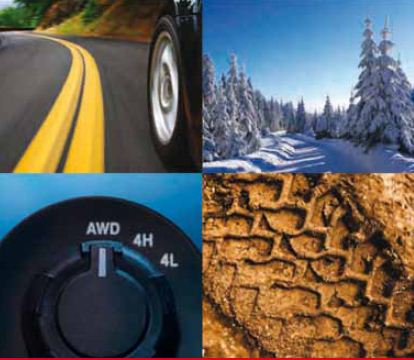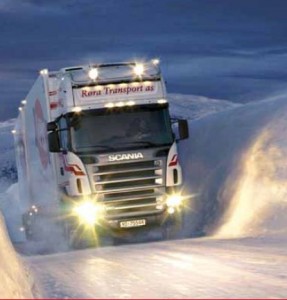Test-drive at Houghton, a thrilling experience
 It was indeed a thrilling experience for a select group of Indian newsmen who recently visited the US-based BorgWarner’s production facilities to test-drive various vehicle models fitted with all-wheel drive (AWD) systems at the snow covered Keweenaw Research Center, Houghton, MI, USA. The test-drive was specially organised by BorgWarner to prove the technical excellence of its range of torque transfer systems. The test proved beyond doubt the extreme manoeuvrability as well reflected in the healthy combination of optimum traction, vehicle speed and driver safety, the prevailing freezing weather notwithstanding.
It was indeed a thrilling experience for a select group of Indian newsmen who recently visited the US-based BorgWarner’s production facilities to test-drive various vehicle models fitted with all-wheel drive (AWD) systems at the snow covered Keweenaw Research Center, Houghton, MI, USA. The test-drive was specially organised by BorgWarner to prove the technical excellence of its range of torque transfer systems. The test proved beyond doubt the extreme manoeuvrability as well reflected in the healthy combination of optimum traction, vehicle speed and driver safety, the prevailing freezing weather notwithstanding.
A century of innovation
A prominent automotive firm, BorgWarner owes its success more or less to its 100 years of innovative technology. In 2011, the company achieved a sales turnover of $7.11 billion as compared to $5.65 billion in the previous year. The workforce of the company has also expanded from 17,500 in 2010 to 19,250 in 2011. The company operations are spread over 60 locations in 19 countries.
All this confirms that BorgWarner has been able to maintain substantial growth not only in the revenue earned but also in its workforce to deliver world standard innovative products.
Though a North American company, BorgWarner has its global presence and enjoys very strong support from the European OEMs. Primarily the company has its major focus on two business divisions, namely, engine systems that contributes 72 per cent of the revenue, and the drive systems that accounts for the balance 28 per cent.
On the occasion, Mr. John A. Barlage, Product Business Director, BorgWarner Drivetrain Systems, made a detailed presentation on the front-wheel drive and its characteristics, while Mr. Hebert Cabral, Marketing Analyst at BorgWarner, gave an overview of the global and regional market trend for AWD.
In India, BorgWarner supplies its torque transfer systems to various OEMs, including Tata Motors and Mahindra & Mahindra. The company mission is to become a leader in every participating global market.
In the 4WD Transfer Cases (RWD AWD) as well as AWD Couplings (FWD AWD) market, BorgWarner continues to be a second top supplier at the global level as in India, and the Divgi-Warner joint venture allows for strong presence in the country. The acquisition of Haldex Traction in 2011 adds to its capabilities and clientele.
The company vision also includes development of leading powertrain technologies that improve fuel economy, emissions and performance.
The factors contributing for higher AWD demand are the industry concern over safety, performance and traction in slippery condition; older and wealthier consumers demanding vehicle safety, stability and security; younger generations demanding premium and luxury vehicles; and legislation insisting on adoption of new safety technologies.
FWD generally exhibits understeer behavior, and the front end tends to “push” out. The driving torque increases the slip angle of the front wheels, limiting lateral grip. The average of the front tyre slip angle is greater than the average of the rear tyre slip angle.
 Rear-Wheel Drive Dyanics (RWD) generally expects oversteer behaviour, wherein rear end “comes around”. Under heavy acceleration, rear drive wheels lose the lateral grip. The average of the rear tyre slip angle is greater than that of the front tyre slip angle.
Rear-Wheel Drive Dyanics (RWD) generally expects oversteer behaviour, wherein rear end “comes around”. Under heavy acceleration, rear drive wheels lose the lateral grip. The average of the rear tyre slip angle is greater than that of the front tyre slip angle.
All this is challenging for inexperienced drivers, since it requires counter steering (in the same direction that the rear of the vehicle is going).
BorgWarner currently has three three patents for the disconnect strategy – US Patent – 2010/0262326 A1 and the Auto mode in production (RWD AWD-based application).
There are three switch models availble. The vehicle will sustain 2WD / AWD regardless of all other inputs, while it will switch between 2WD and AWD depending upon driving / environmental conditions and aggressive driving.
AWD environment variables relate to ambient temperature, windshield wipers, driving surface friction coefficient and hill detection, while AWD driving variables relate to aggressive launch (high throttle and clutch slip), unintended clutch slip, excessive lateral / longitudinal acceleration, aggressive steering manoeuvres and ABS events. The driving and environmental conditions are combined to create a map that defines when to enter and exit the AWD mode.